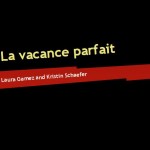Summary
This was a real-world project for French 3. In pairs, the students selected one or two foreign destinations to visit. They researched and put together a travel itinerary on a budget of $5000 for two people. Students used Google Drive to communicate even when they were out of school and the teacher could monitor their progress. Students put together a presentation of their trip using Google Presentation, Prezi, or Power Point. They had to research transportation, accommodations, restaurants, and places to see, and keep within their budget. This project was completed solely in French and incorporated vocabulary of the unit as well as ‘world’ knowledge. Students also learned constraints of a budget in international travel.
TIPC Ratings
The teacher gave the students a few travel sites to start with (example: orbitz, expedia, travelocity); however, students were encouraged to look for others. Students were responsible for gathering all of their own information. Therefore, they had to determine which information would be relevant, and what the best informational sources would be.
Students researched airline websites, hotel websites, restaurants, chamber of commerce-like sites, tourist sites that included good places to visit, tour websites, Rail Europe, Trip Advisor, and other International websites – all which they had to be translated either from French to English or vice versa.
For the specifics for itinerary, students had to choose hotels that were affordable and they had to choose restaurants that were easy to get to from where they were staying. They had to determine how they would get around (ex. bus, car, train) and schedules. With tourist sites, they had to consider hours of operation, days open, prices (including student passes/discounts) and had to organize a detailed calendar. The itinerary’s were based on real-world experiences and the students themselves hope to one day be able to take the trip.
As students found good sites, they shared them with each other throughout the class. Personal family anecdotes were also shared. And, the students also referred to their textbooks for appropriate vocabulary and grammar.
Students worked in self selected pairs. Each pair decided how to split up work for research on flights, hotels, restaurants, etc. Each member of the group had a role in researching and a role in creating the presentation.
Students communicated and collaborated outside the classroom on a Google Document. They included notes from their research as well as their travel itinerary. The teacher could monitor each groups work via the Google Doc to ensure they stayed on task. Students also collaborated on the presentation. Many chose to use Google Presentation or Prezi, in which the pairs could collaborate after school hours and at home.
When the projects were completed, students gave oral presentations of their city to the rest of the class. And there was an oral reflection facilitated by the teacher. Students reflected on their experiences working on this lesson. All student oral and written communication was in French.
This was an open ended project and presentation. Students had to agree with their travel partner about where to stay, what to see, and how to get around. They used several digital tools to complete the activities. These included internet-based research, Google Drive, and a variety of web-based presentation tools. Since this was the student’s first year of complete immersion of French all work was done in French and this was very challenging for the students.
At the conclusion of the lesson, there was an oral student reflection of the students’ experiences completing this project. They were interested to hear what each other had learned. Students discovered that some airlines and tourist sites offered student discounts. They also learned about youth hostels as a means for accommodation. And, they were quite surprised to learn how expensive overseas travel can be.
Students were given a great deal of personal choice with this project. They had to decide on what city or cities they would visit, what they would see, how they would get around, where they would eat, and much more. They had to synthesis and organize all the information they found in their research to create a real-world product that could be used by anyone. They also had to decide on the presentation tool would best suit their needs – Google Presentation, Prezi, Power Point, or any other program. The students were very creative in the images they chose, background color’s, fonts, etc.
When the projects were completed, students gave oral presentations of their city to the rest of the class. The oral presentation was solely in French.
Download Files
- H21 Lesson Plan
- Lesson Plan (French)
- Lesson Plan (English)
- Student Notes & Prezi
- Student Artifact – Travelling Project





